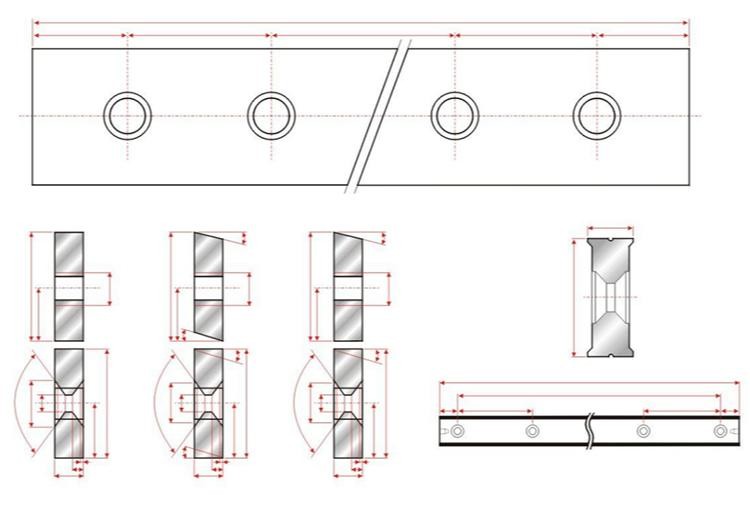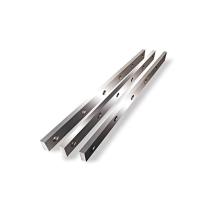Tungsten Carbide Steel Slotted Slitter Industrial Cutter Knife
Blade With Four Holes
Description:
Industrial slit saw blades used in slitting and longitudinal
cutting machines have the following key features and
characteristics:
1,Blade Profile and Geometry:
- Slit saw blades typically feature a narrow, elongated profile to
enable precise and clean cuts along the length of the material
being processed.
- The blade geometry is often asymmetric or irregular, with
specialized tooth patterns and edge designs tailored to the
specific cutting application.
2,Material Composition:
- Slit saw blades are commonly made from high-performance tool
steels, such as M2 or M42 high-speed steel, or carbide-tipped
designs for increased wear resistance.
- The material selection is crucial to ensure the blades can
withstand the high stresses and loads encountered during the
slitting or longitudinal cutting process.
3,Kerf Width and Precision:
- The kerf width, which is the width of the cut made by the slit saw
blade, is a critical parameter that needs to be precisely
controlled.
- Narrow kerf widths are desirable to maximize material yield and
minimize waste, while maintaining the necessary cutting precision
and edge quality.
4,Vibration Dampening:
- Slit saw blades are designed with features or mounting
configurations that help dampen vibrations during the cutting
process.
- This vibration control is essential for maintaining the desired
cutting accuracy and surface finish of the slit or longitudinal
cuts.
5,Cooling and Lubrication:
- Effective cooling and lubrication systems are often integrated into
the slit saw blade design or the cutting machinery.
- This helps dissipate heat buildup, reduce friction, and extend the
blade's lifespan by preventing premature wear or damage.
6,Blade Sharpening and Maintenance:
- Slit saw blades are typically designed to be resharpened and
maintained to prolong their usable life.
- Special sharpening equipment and techniques are employed to restore
the blade's cutting edge without compromising its geometry or
performance characteristics.
7,Quality Control and Consistency:
- Rigorous quality control measures are implemented in the
manufacturing of slit saw blades to ensure consistent performance,
dimensional accuracy, and edge quality.
- This includes comprehensive testing, inspection, and validation
procedures to meet the required specifications for each cutting
application.
Industrial Blade Specifications:
| Product name | Slotted Slitter Industrial Cutter Knife Blade |
| Material | Tungsten Carbide Steel |
| Hardness | HRC89.5-92 |
| Precision | ±50 Micron |
| Length | 100mm |
| Width | 18mm |
| Thickness | 0.4mm |
| Applicable Industries | Manufacturing Plant |
The lifespan of industrial slit saw blades used in slitting and
longitudinal cutting machines depends on various factors, but with
proper care and maintenance, these blades can have an extended
useful life. Here are some key considerations regarding the typical
lifespan of slit saw blades:
1,Blade Material and Design:
- Blades made from high-quality tool steels or carbide-tipped designs
generally have a longer lifespan compared to standard carbon steel
blades.
- The blade geometry, tooth pattern, and edge design also play a
crucial role in the blade's wear resistance and cutting
performance.
2,Cutting Application and Conditions:
- The type of material being cut, cutting speeds, feed rates, and
environmental factors can significantly impact the blade's
lifespan.
- Cutting softer materials, such as plastics or thin metals, tends to
result in longer blade life compared to cutting harder, more
abrasive materials.
3,Blade Maintenance and Sharpening:
- Regular inspection, cleaning, and timely resharpening of slit saw
blades can dramatically extend their usable lifespan.
- Proper sharpening techniques, performed by experienced
professionals, can restore the blade's cutting edge without
compromising its structural integrity.
4,Cutting Fluid and Lubrication:
- The use of appropriate cutting fluids and lubrication systems helps
dissipate heat, reduce friction, and minimize wear on the slit saw
blades.
- Maintaining the cutting fluid and regularly replacing it can
prolong the blade's lifespan.
5,Blade Mounting and Alignment:
- Ensuring the blades are properly mounted and aligned in the
slitting or longitudinal cutting machinery is crucial to prevent
excessive vibration and uneven wear.
- Proper blade setup and maintenance can significantly extend the
blade's usable life.
6,Operator Training and Handling:
- Educating machine operators on proper blade handling, cutting
techniques, and maintenance procedures can help prevent premature
blade failure or damage.
- Encouraging a culture of care and attention to detail when working
with slit saw blades is important.
Picture:


Size:

Applications:

Packing:











